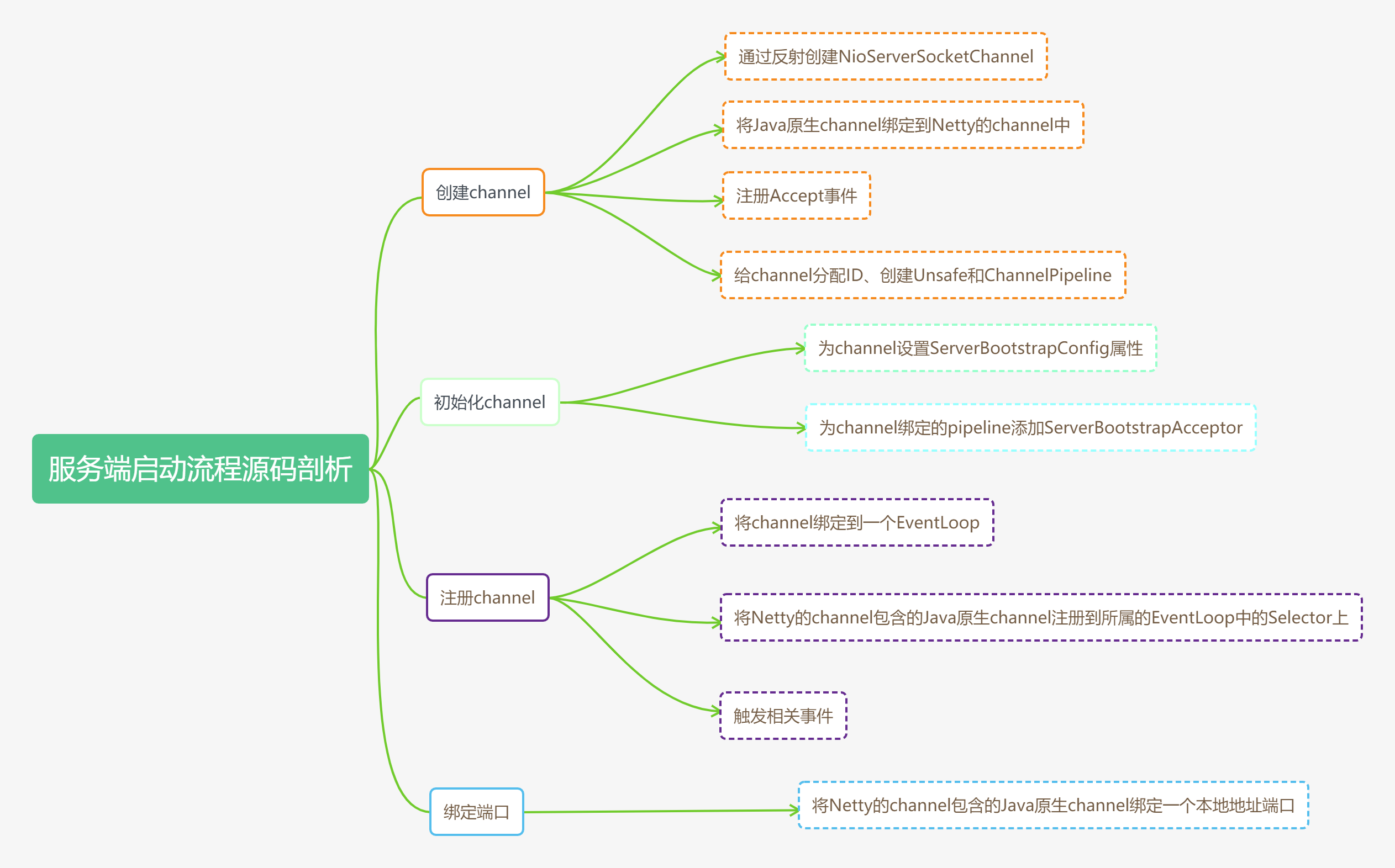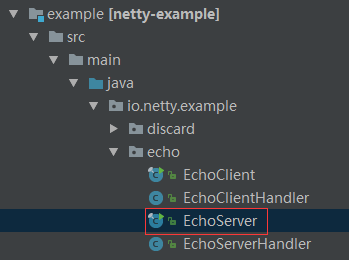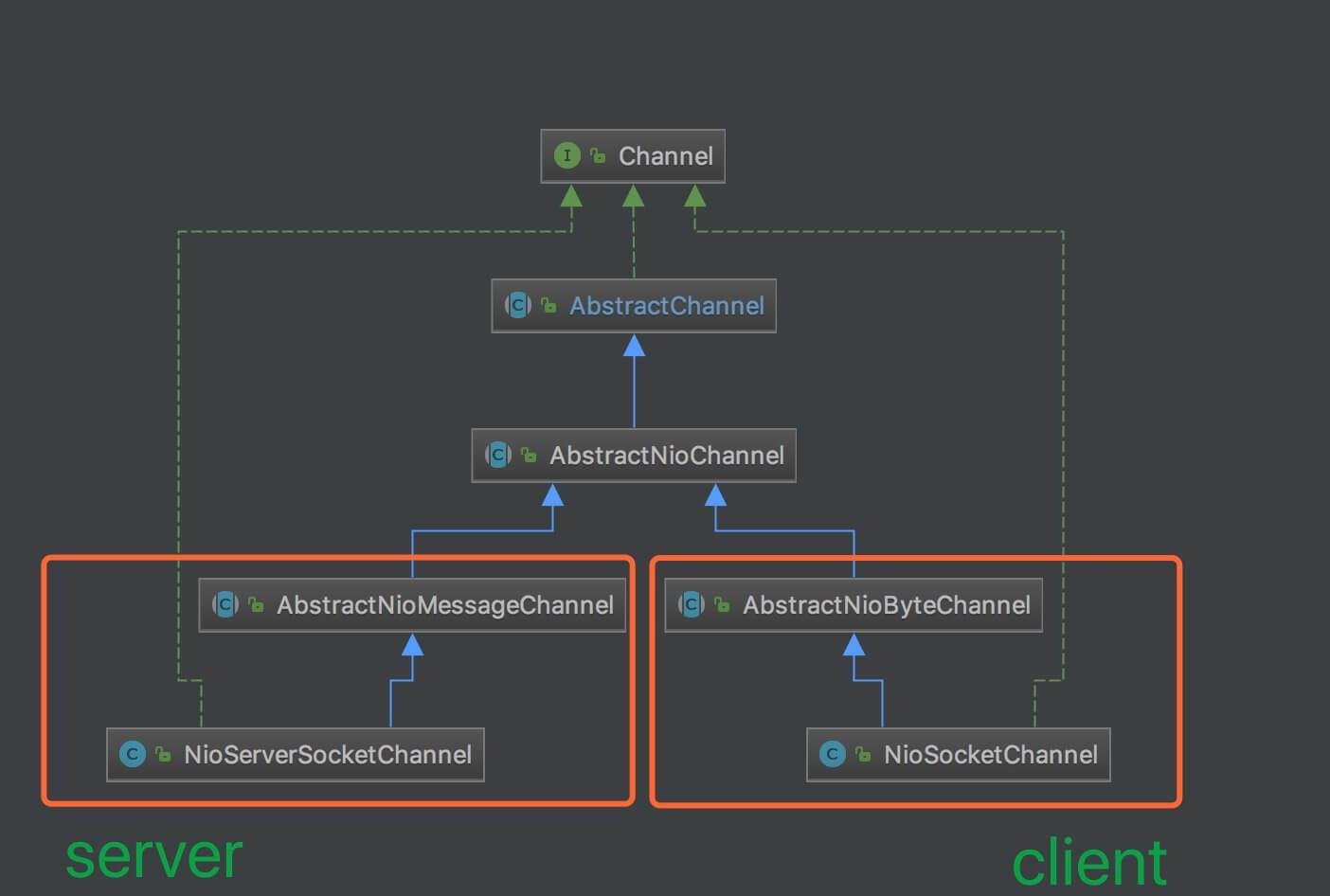Netty之旅三:Netty服務端啟動原始碼分析,一梭子帶走!
阿新 • • 發佈:2020-09-15
# Netty服務端啟動流程原始碼分析

## 前記
哈嘍,自從上篇《Netty之旅二:口口相傳的高效能Netty到底是什麼?》後,遲遲兩週才開啟今天的`Netty`原始碼系列。原始碼分析的第一篇文章,下一篇我會分享客戶端的啟動過程原始碼分析。通過原始碼的閱讀,我們將會知道,`Netty` 服務端啟動的呼叫鏈是非常長的,同時肯定也會發現一些新的問題,隨著我們原始碼閱讀的不斷深入,相信這些問題我們也會一一攻破。
廢話不多說,直接上號!

## 一、從EchoServer示例入手

示例從哪裡來?任何開源框架都會有自己的示例程式碼,Netty原始碼也不例外,如模組`netty-example`中就包括了最常見的`EchoServer`示例,下面通過這個示例進入服務端啟動流程篇章。
```java
public final class EchoServer {
static final boolean SSL = System.getProperty("ssl") != null;
static final int PORT = Integer.parseInt(System.getProperty("port", "8007"));
public static void main(String[] args) throws Exception {
// Configure SSL.
final SslContext sslCtx;
if (SSL) {
SelfSignedCertificate ssc = new SelfSignedCertificate();
sslCtx = SslContextBuilder.forServer(ssc.certificate(), ssc.privateKey()).build();
} else {
sslCtx = null;
}
// 1. 宣告Main-Sub Reactor模式執行緒池:EventLoopGroup
// Configure the server.
EventLoopGroup bossGroup = new NioEventLoopGroup(1);
EventLoopGroup workerGroup = new NioEventLoopGroup();
// 建立 EchoServerHandler 物件
final EchoServerHandler serverHandler = new EchoServerHandler();
try {
// 2. 宣告服務端啟動引導器,並設定相關屬性
ServerBootstrap b = new ServerBootstrap();
b.group(bossGroup, workerGroup)
.channel(NioServerSocketChannel.class)
.option(ChannelOption.SO_BACKLOG, 100)
.handler(new LoggingHandler(LogLevel.INFO))
.childHandler(new ChannelInitializer() {
@Override
public void initChannel(SocketChannel ch) throws Exception {
ChannelPipeline p = ch.pipeline();
if (sslCtx != null) {
p.addLast(sslCtx.newHandler(ch.alloc()));
}
//p.addLast(new LoggingHandler(LogLevel.INFO));
p.addLast(serverHandler);
}
});
// 3. 繫結埠即啟動服務端,並同步等待
// Start the server.
ChannelFuture f = b.bind(PORT).sync();
// 4. 監聽服務端關閉,並阻塞等待
// Wait until the server socket is closed.
f.channel().closeFuture().sync();
} finally {
// 5. 優雅地關閉兩個EventLoopGroup執行緒池
// Shut down all event loops to terminate all threads.
bossGroup.shutdownGracefully();
workerGroup.shutdownGracefully();
}
}
}
```
1. [程式碼行18、19]宣告`Main-Sub Reactor`模式執行緒池:`EventLoopGroup`
建立兩個` EventLoopGroup` 物件。其中,`bossGroup`用於服務端接受客戶端的連線,`workerGroup`用於進行客戶端的 `SocketChannel `的資料讀寫。
(關於`EventLoopGroup`不是本文重點所以在後續文章中進行分析 (
ObjectUtil.checkNotNull(channelClass, "channelClass")
));
}
```
這個方法正是在`EchoServer`中`ServerBootstrap`鏈式設定時呼叫`.channel(NioServerSocketChannel.class)`的方法。我們看到,`channelClass`就是`NioServerSocketChannel.class`,`channelFactory`也是以`ReflectiveChannelFactory`作為具體例項,並且將`NioServerSocketChannel.class`作為構造引數傳遞初始化的,所以這回答了反射機制構造的是`io.netty.channel.socket.nio.NioServerSocketChannel`物件。
繼續看`NioServerSocketChannel`構造方法邏輯做了什麼事情,看之前先給出`NioServerSocketChannel`類繼承關係:

`NioServerSocketChannel`與`NioSocketChannel`分別對應服務端和客戶端,公共父類都是`AbstractNioChannel`和`AbstractChannel`,下面介紹建立過程可以參照這個`Channel`類繼承圖。進入`NioServerSocketChannel`構造方法:
```java
/**
* Create a new instance
*/
public NioServerSocketChannel() {
this(newSocket(DEFAULT_SELECTOR_PROVIDER));
}
```
點選`newSocket`進去:
```java
private static ServerSocketChannel newSocket(SelectorProvider provider) {
try {
/**
* Use the {@link SelectorProvider} to open {@link SocketChannel} and so remove condition in
* {@link SelectorProvider#provider()} which is called by each ServerSocketChannel.open() otherwise.
*
* See #2308.
*/
return provider.openServerSocketChannel();
} catch (IOException e) {
throw new ChannelException(
"Failed to open a server socket.", e);
}
}
```
以上傳進來的`provider`是`DEFAULT_SELECTOR_PROVIDER`即預設的`java.nio.channels.spi.SelectorProvider`,[程式碼行9]就是熟悉的`jdk nio`建立`ServerSocketChannel`。這樣`newSocket(DEFAULT_SELECTOR_PROVIDER)`就返回了結果`ServerSocketChannel`,回到`NioServerSocketChannel()#this()`點進去:
```java
/**
* Create a new instance using the given {@link ServerSocketChannel}.
*/
public NioServerSocketChannel(ServerSocketChannel channel) {
super(null, channel, SelectionKey.OP_ACCEPT);
config = new NioServerSocketChannelConfig(this, javaChannel().socket());
}
```
以上`super`代表父類`AbstractNioMessageChannel`構造方法,點進去看到:
```java
/**
* @see AbstractNioChannel#AbstractNioChannel(Channel, SelectableChannel, int)
*/
protected AbstractNioMessageChannel(Channel parent, SelectableChannel ch, int readInterestOp) {
super(parent, ch, readInterestOp);
}
```
以上`super`代表父類`AbstractNioChannel`構造方法,點進去看到:
```java
protected AbstractNioChannel(Channel parent, SelectableChannel ch, int readInterestOp) {
super(parent);
this.ch = ch;
this.readInterestOp = readInterestOp;
try {
ch.configureBlocking(false);
} catch (IOException e) {
try {
ch.close();
} catch (IOException e2) {
if (logger.isWarnEnabled()) {
logger.warn("Failed to close a partially initialized socket.", e2);
}
}
throw new ChannelException("Failed to enter non-blocking mode.", e);
}
}
```
以上[程式碼行3]將`ServerSocketChannel`儲存到了`AbstractNioChannel#ch`成員變數,在上面提到的`NioServerSocketChannel`構造方法的[程式碼行6]`javaChannel()`拿到的就是`ch`儲存的`ServerSocketChannel`變數。
以上[程式碼行6]就是熟悉的`jdk nio`程式設計設定`ServerSocketChannel`非阻塞方式。這裡還有`super`父類構造方法,點選進去看到:
```java
protected AbstractChannel(Channel parent) {
this.parent = parent;
id = newId();
unsafe = newUnsafe();
pipeline = newChannelPipeline();
}
```
以上構造方法中:
- `parent` 屬性,代表父` Channel` 物件。對於` NioServerSocketChannel `的 `parent` 為`null`。
- `id` 屬性,`Channel `編號物件。在構造方法中,通過呼叫 `#newId()` 方法進行建立。(這裡不細展開Problem-1 , Object> options = options0();
synchronized (options) {
setChannelOptions(channel, options, logger);
}
final Map, Object> attrs = attrs0();
synchronized (attrs) {
for (Entry, Object> e: attrs.entrySet()) {
@SuppressWarnings("unchecked")
AttributeKey
